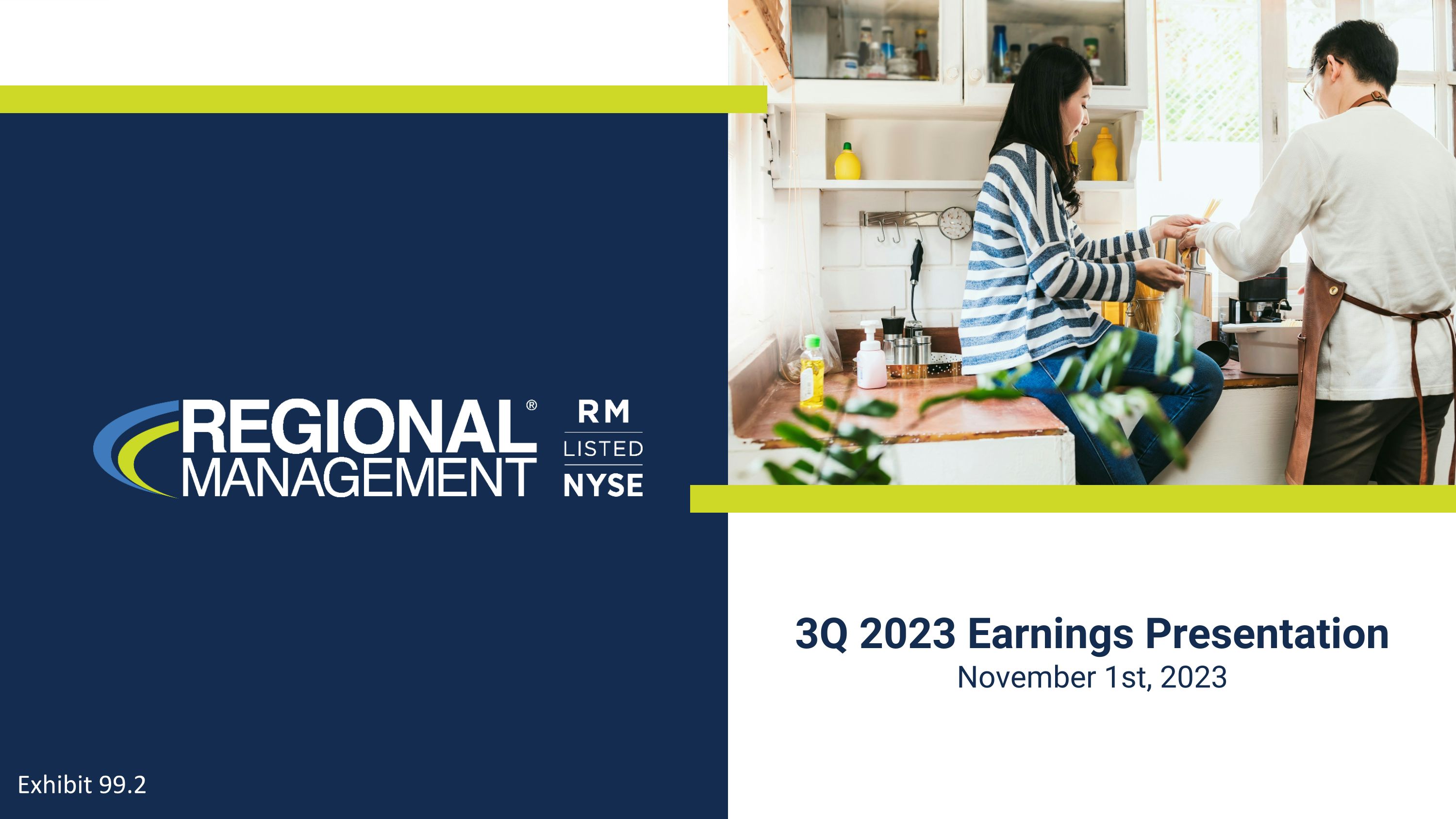
3Q 2023 Earnings Presentation November 1st, 2023 Exhibit 99.2
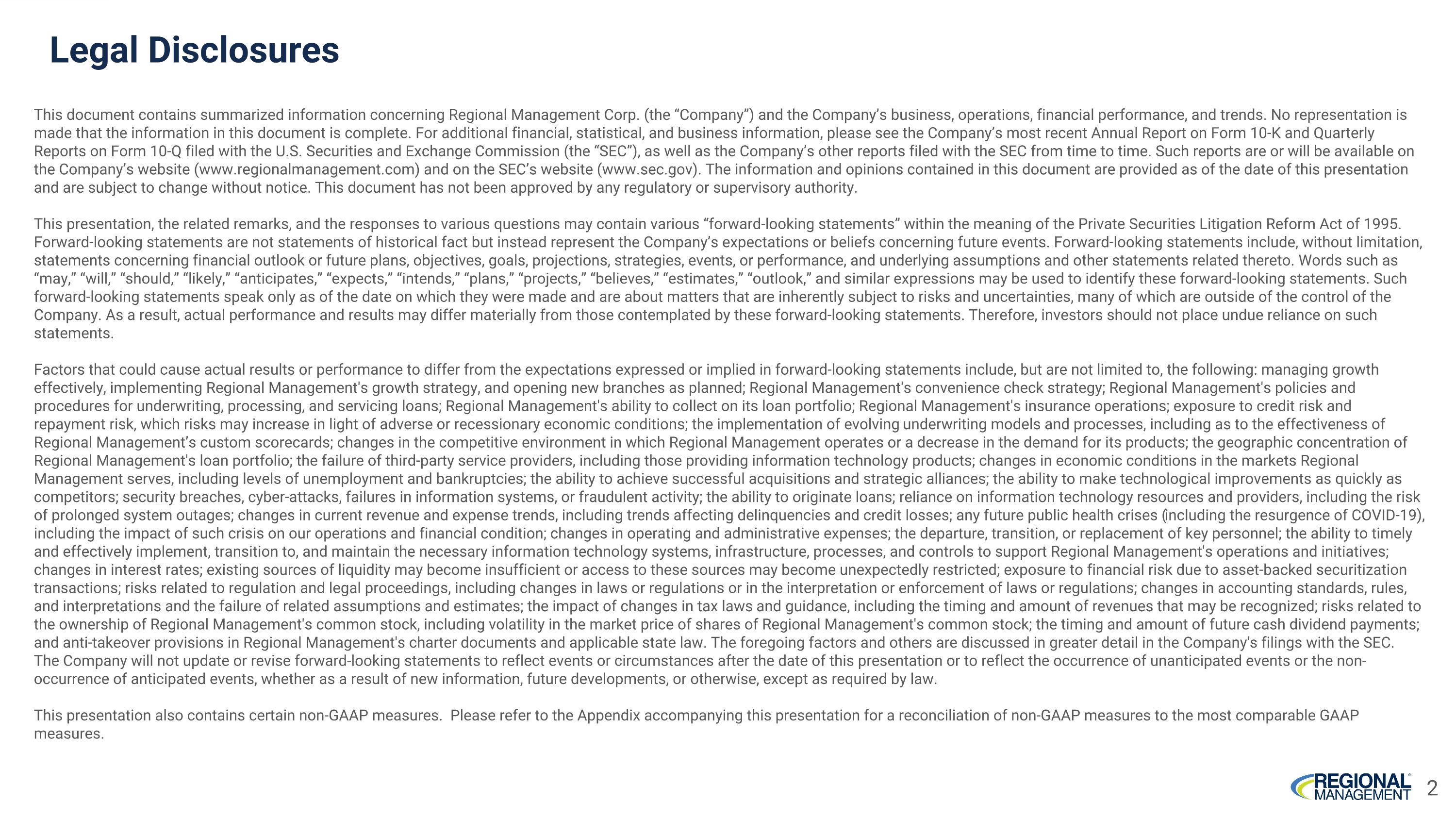
Legal Disclosures This document contains summarized information concerning Regional Management Corp. (the “Company”) and the Company’s business, operations, financial performance, and trends. No representation is made that the information in this document is complete. For additional financial, statistical, and business information, please see the Company’s most recent Annual Report on Form 10-K and Quarterly Reports on Form 10-Q filed with the U.S. Securities and Exchange Commission (the “SEC”), as well as the Company’s other reports filed with the SEC from time to time. Such reports are or will be available on the Company’s website (www.regionalmanagement.com) and on the SEC’s website (www.sec.gov). The information and opinions contained in this document are provided as of the date of this presentation and are subject to change without notice. This document has not been approved by any regulatory or supervisory authority. This presentation, the related remarks, and the responses to various questions may contain various “forward-looking statements” within the meaning of the Private Securities Litigation Reform Act of 1995. Forward-looking statements are not statements of historical fact but instead represent the Company’s expectations or beliefs concerning future events. Forward-looking statements include, without limitation, statements concerning financial outlook or future plans, objectives, goals, projections, strategies, events, or performance, and underlying assumptions and other statements related thereto. Words such as “may,” “will,” “should,” “likely,” “anticipates,” “expects,” “intends,” “plans,” “projects,” “believes,” “estimates,” “outlook,” and similar expressions may be used to identify these forward-looking statements. Such forward-looking statements speak only as of the date on which they were made and are about matters that are inherently subject to risks and uncertainties, many of which are outside of the control of the Company. As a result, actual performance and results may differ materially from those contemplated by these forward-looking statements. Therefore, investors should not place undue reliance on such statements. Factors that could cause actual results or performance to differ from the expectations expressed or implied in forward-looking statements include, but are not limited to, the following: managing growth effectively, implementing Regional Management's growth strategy, and opening new branches as planned; Regional Management's convenience check strategy; Regional Management's policies and procedures for underwriting, processing, and servicing loans; Regional Management's ability to collect on its loan portfolio; Regional Management's insurance operations; exposure to credit risk and repayment risk, which risks may increase in light of adverse or recessionary economic conditions; the implementation of evolving underwriting models and processes, including as to the effectiveness of Regional Management’s custom scorecards; changes in the competitive environment in which Regional Management operates or a decrease in the demand for its products; the geographic concentration of Regional Management's loan portfolio; the failure of third-party service providers, including those providing information technology products; changes in economic conditions in the markets Regional Management serves, including levels of unemployment and bankruptcies; the ability to achieve successful acquisitions and strategic alliances; the ability to make technological improvements as quickly as competitors; security breaches, cyber-attacks, failures in information systems, or fraudulent activity; the ability to originate loans; reliance on information technology resources and providers, including the risk of prolonged system outages; changes in current revenue and expense trends, including trends affecting delinquencies and credit losses; any future public health crises (including the resurgence of COVID-19), including the impact of such crisis on our operations and financial condition; changes in operating and administrative expenses; the departure, transition, or replacement of key personnel; the ability to timely and effectively implement, transition to, and maintain the necessary information technology systems, infrastructure, processes, and controls to support Regional Management's operations and initiatives; changes in interest rates; existing sources of liquidity may become insufficient or access to these sources may become unexpectedly restricted; exposure to financial risk due to asset-backed securitization transactions; risks related to regulation and legal proceedings, including changes in laws or regulations or in the interpretation or enforcement of laws or regulations; changes in accounting standards, rules, and interpretations and the failure of related assumptions and estimates; the impact of changes in tax laws and guidance, including the timing and amount of revenues that may be recognized; risks related to the ownership of Regional Management's common stock, including volatility in the market price of shares of Regional Management's common stock; the timing and amount of future cash dividend payments; and anti-takeover provisions in Regional Management's charter documents and applicable state law. The foregoing factors and others are discussed in greater detail in the Company's filings with the SEC. The Company will not update or revise forward-looking statements to reflect events or circumstances after the date of this presentation or to reflect the occurrence of unanticipated events or the non-occurrence of anticipated events, whether as a result of new information, future developments, or otherwise, except as required by law. This presentation also contains certain non-GAAP measures. Please refer to the Appendix accompanying this presentation for a reconciliation of non-GAAP measures to the most comparable GAAP measures. 2
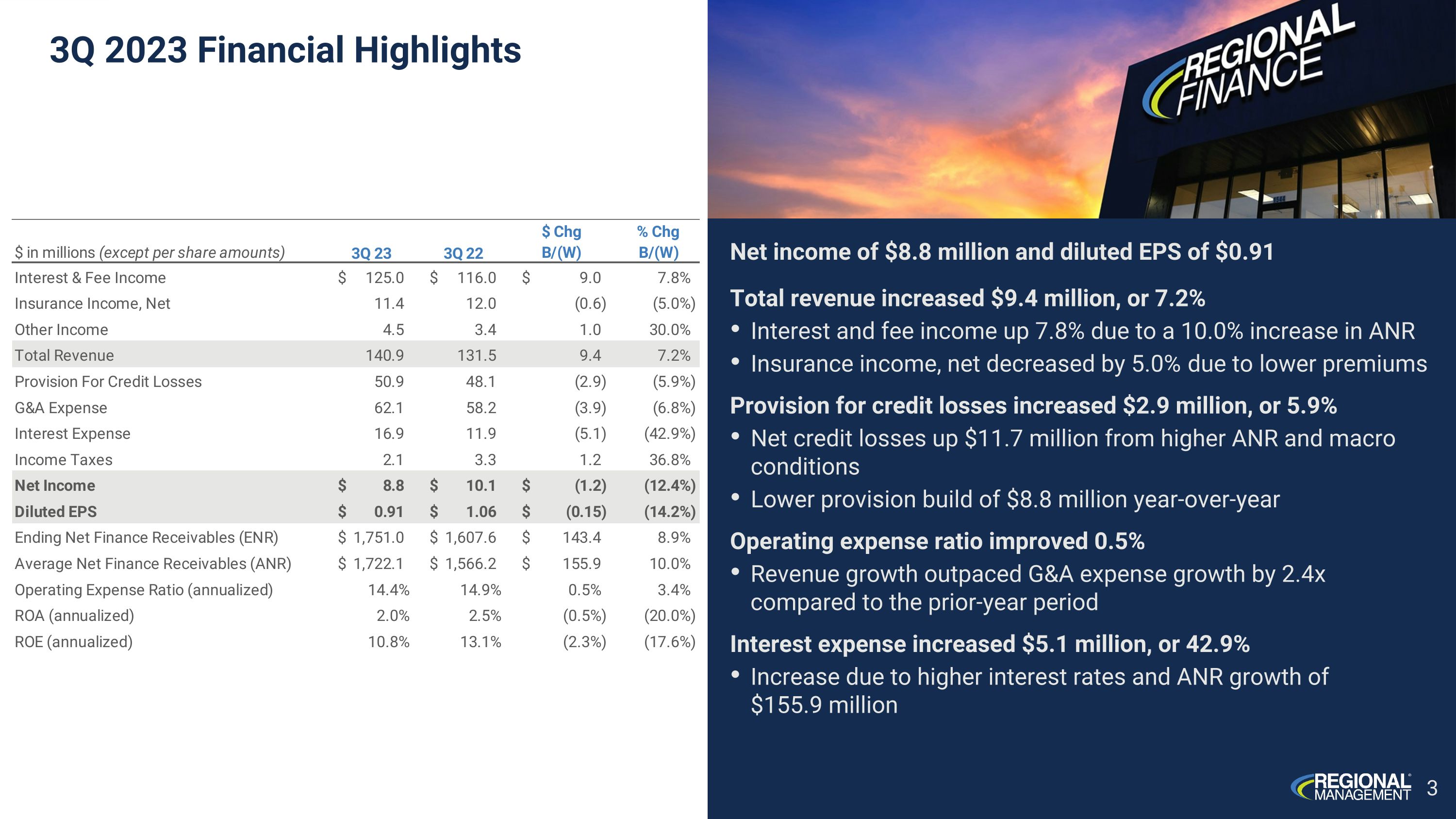
3Q 2023 Financial Highlights Net income of $8.8 million and diluted EPS of $0.91 Total revenue increased $9.4 million, or 7.2% Interest and fee income up 7.8% due to a 10.0% increase in ANR Insurance income, net decreased by 5.0% due to lower premiums Provision for credit losses increased $2.9 million, or 5.9% Net credit losses up $11.7 million from higher ANR and macro conditions Lower provision build of $8.8 million year-over-year Operating expense ratio improved 0.5% Revenue growth outpaced G&A expense growth by 2.4x compared to the prior-year period Interest expense increased $5.1 million, or 42.9% Increase due to higher interest rates and ANR growth of $155.9 million 3
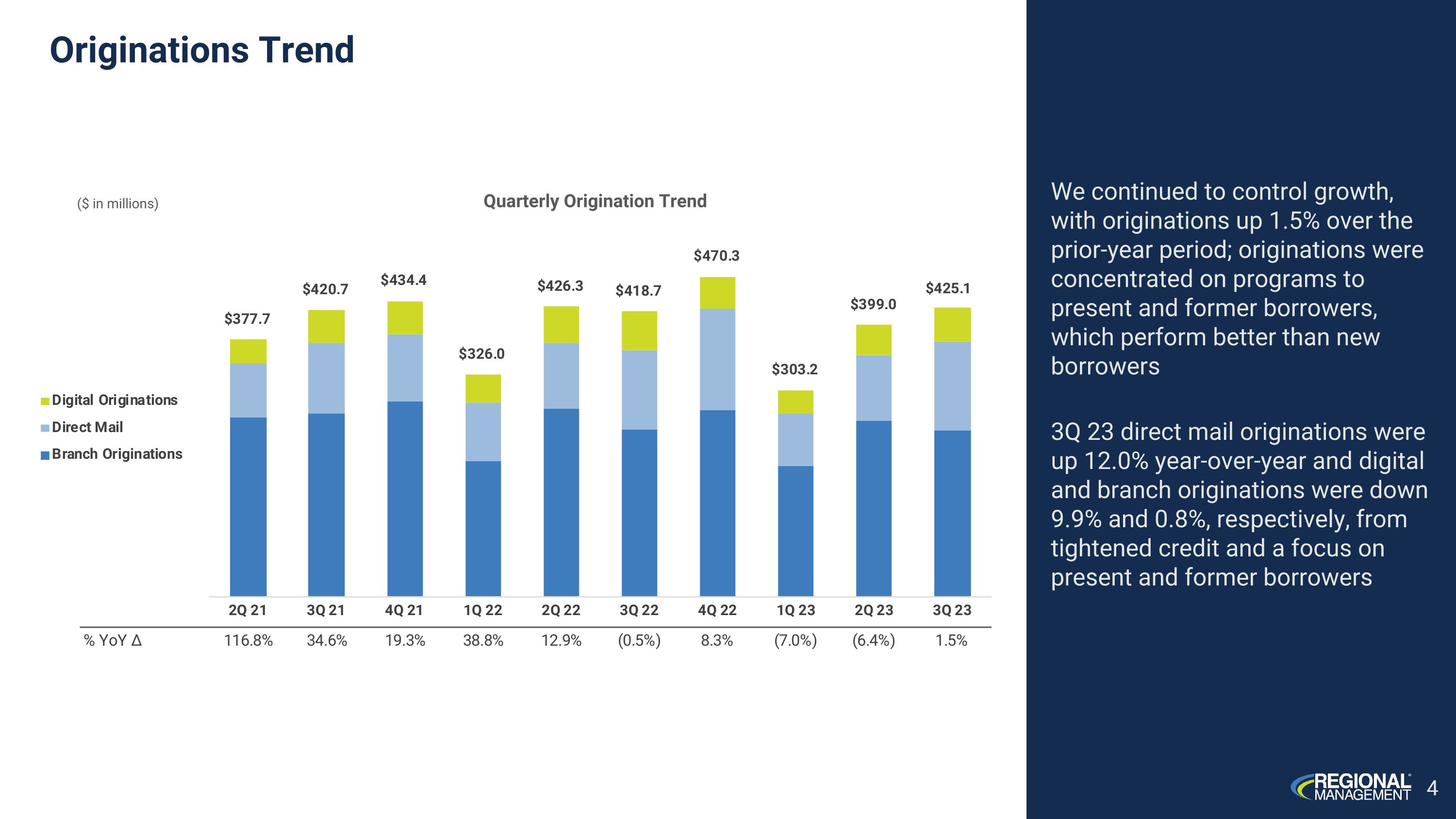
We continued to control growth, with originations up 1.5% over the prior-year period; originations were concentrated on programs to present and former borrowers, which perform better than new borrowers 3Q 23 direct mail originations were up 12.0% year-over-year and digital and branch originations were down 9.9% and 0.8%, respectively, from tightened credit and a focus on present and former borrowers Quarterly Origination Trend 4 ($ in millions) Originations Trend
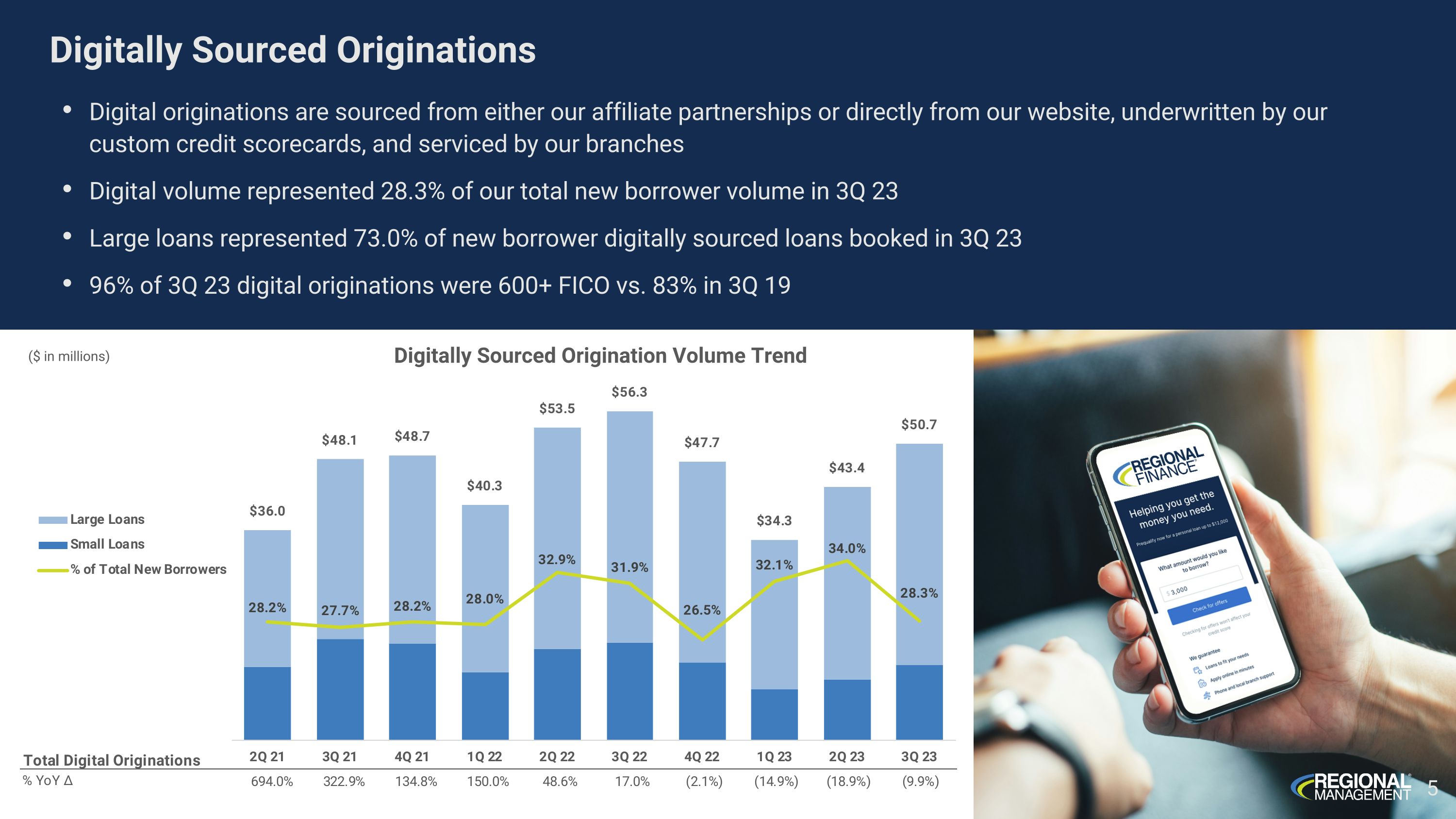
Digital originations are sourced from either our affiliate partnerships or directly from our website, underwritten by our custom credit scorecards, and serviced by our branches Digital volume represented 28.3% of our total new borrower volume in 3Q 23 Large loans represented 73.0% of new borrower digitally sourced loans booked in 3Q 23 96% of 3Q 23 digital originations were 600+ FICO vs. 83% in 3Q 19 Digitally Sourced Origination Volume Trend 5 ($ in millions) Digitally Sourced Originations
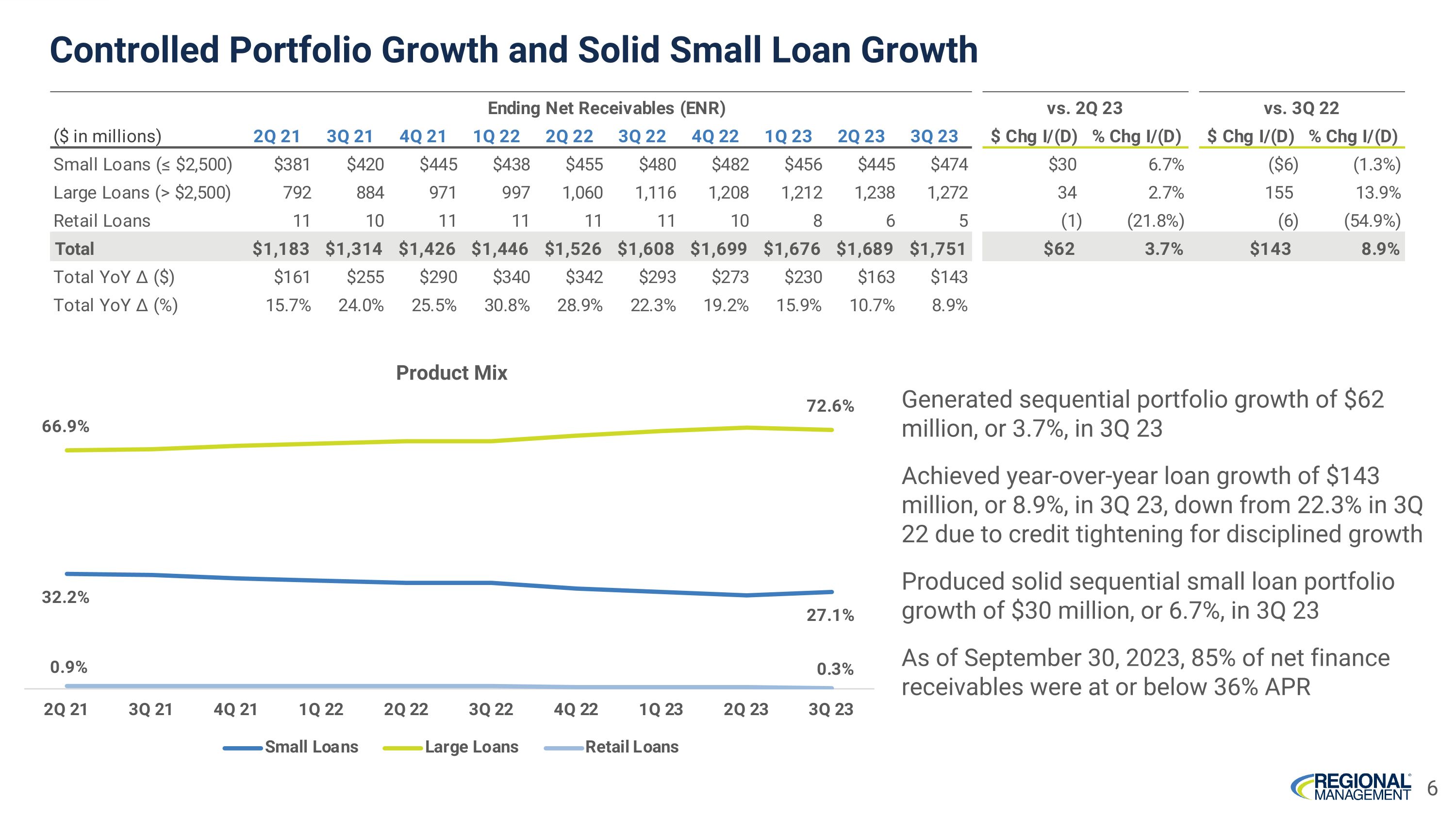
Controlled Portfolio Growth and Solid Small Loan Growth Generated sequential portfolio growth of $62 million, or 3.7%, in 3Q 23 Achieved year-over-year loan growth of $143 million, or 8.9%, in 3Q 23, down from 22.3% in 3Q 22 due to credit tightening for disciplined growth Produced solid sequential small loan portfolio growth of $30 million, or 6.7%, in 3Q 23 As of September 30, 2023, 85% of net finance receivables were at or below 36% APR Product Mix 6
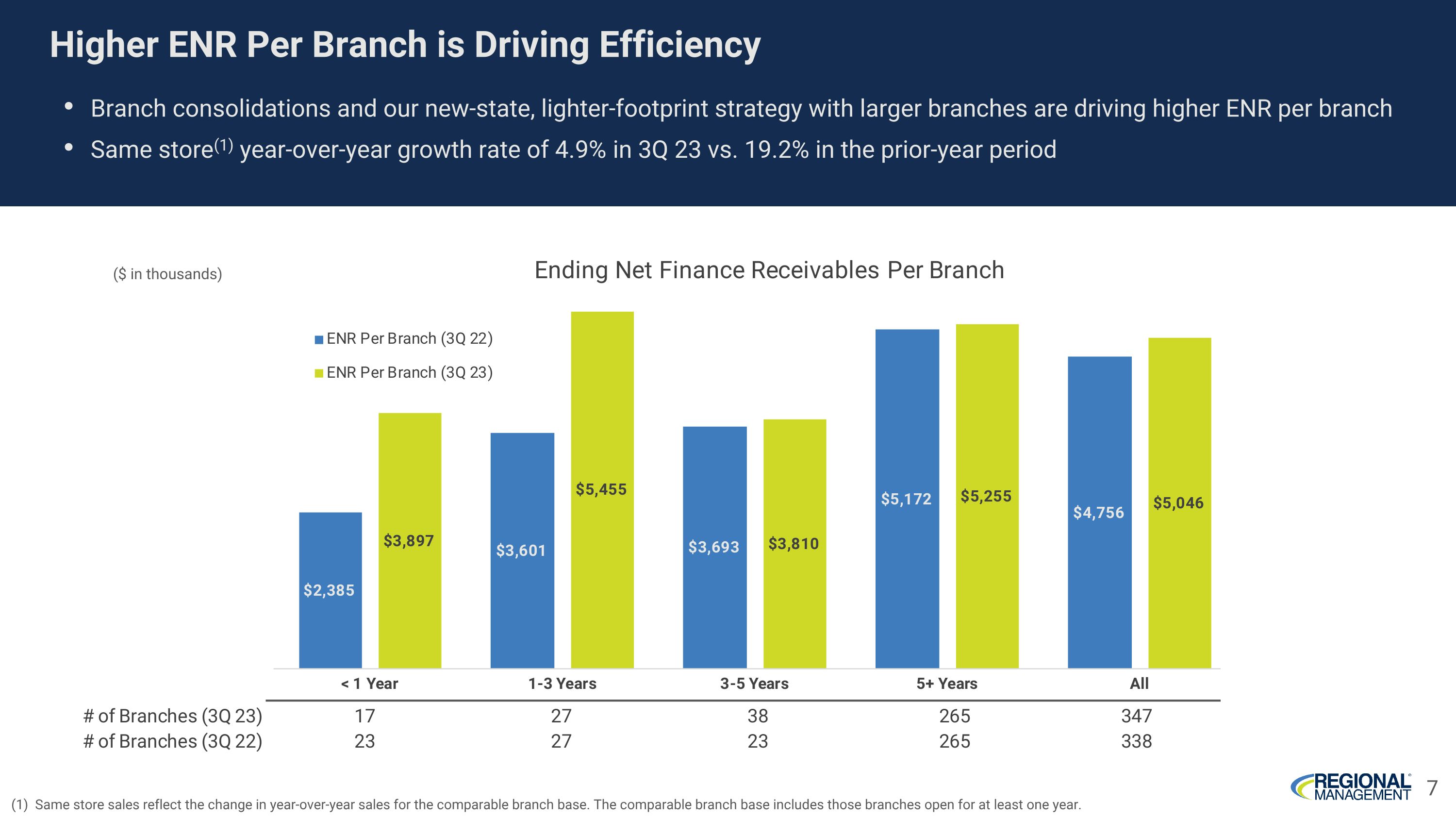
Higher ENR Per Branch is Driving Efficiency (1) Same store sales reflect the change in year-over-year sales for the comparable branch base. The comparable branch base includes those branches open for at least one year. 7 ($ in thousands) Branch consolidations and our new-state, lighter-footprint strategy with larger branches are driving higher ENR per branch Same store(1) year-over-year growth rate of 4.9% in 3Q 23 vs. 19.2% in the prior-year period
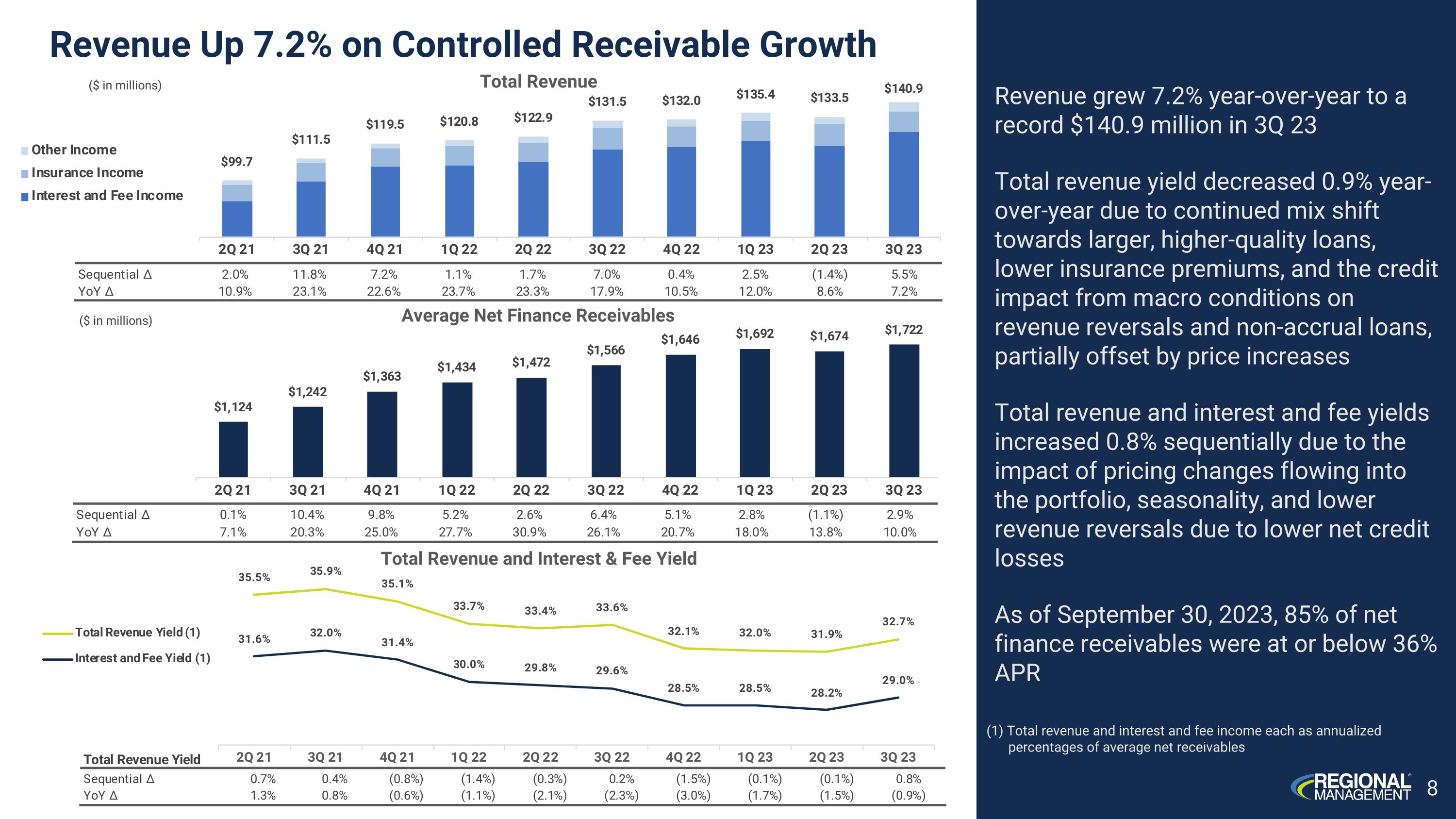
Revenue grew 7.2% year-over-year to a record $140.9 million in 3Q 23 Total revenue yield decreased 0.9% year-over-year due to continued mix shift towards larger, higher-quality loans, lower insurance premiums, and the credit impact from macro conditions on revenue reversals and non-accrual loans, partially offset by price increases Total revenue and interest and fee yields increased 0.8% sequentially due to the impact of pricing changes flowing into the portfolio, seasonality, and lower revenue reversals due to lower net credit losses As of September 30, 2023, 85% of net finance receivables were at or below 36% APR Total Revenue Average Net Finance Receivables Total Revenue and Interest & Fee Yield 8 ($ in millions) ($ in millions) Revenue Up 7.2% on Controlled Receivable Growth (1) Total revenue and interest and fee income each as annualized percentages of average net receivables
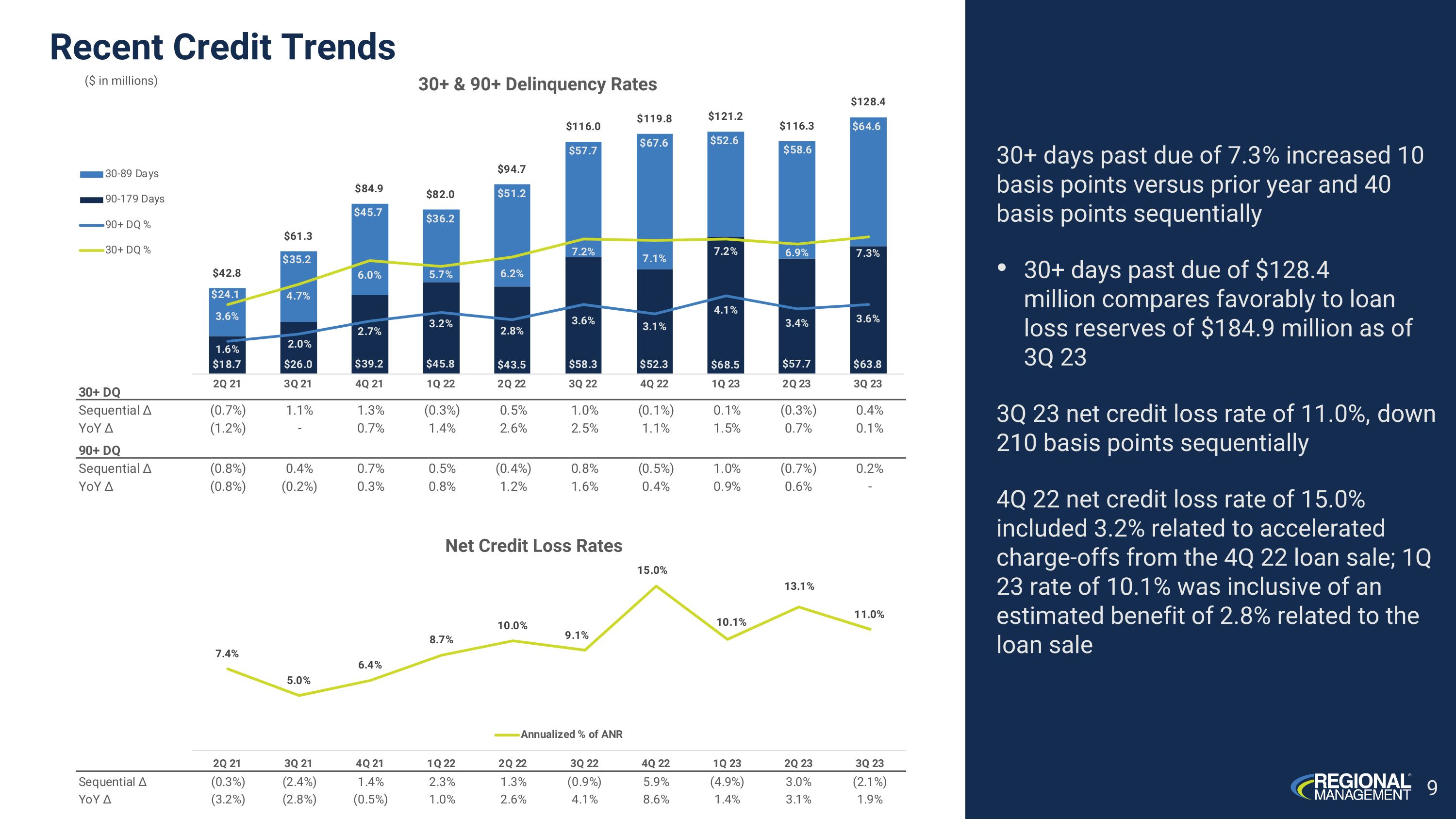
Recent Credit Trends 30+ days past due of 7.3% increased 10 basis points versus prior year and 40 basis points sequentially 30+ days past due of $128.4 million compares favorably to loan loss reserves of $184.9 million as of 3Q 23 3Q 23 net credit loss rate of 11.0%, down 210 basis points sequentially 4Q 22 net credit loss rate of 15.0% included 3.2% related to accelerated charge-offs from the 4Q 22 loan sale; 1Q 23 rate of 10.1% was inclusive of an estimated benefit of 2.8% related to the loan sale 30+ & 90+ Delinquency Rates ($ in millions) Net Credit Loss Rates 9
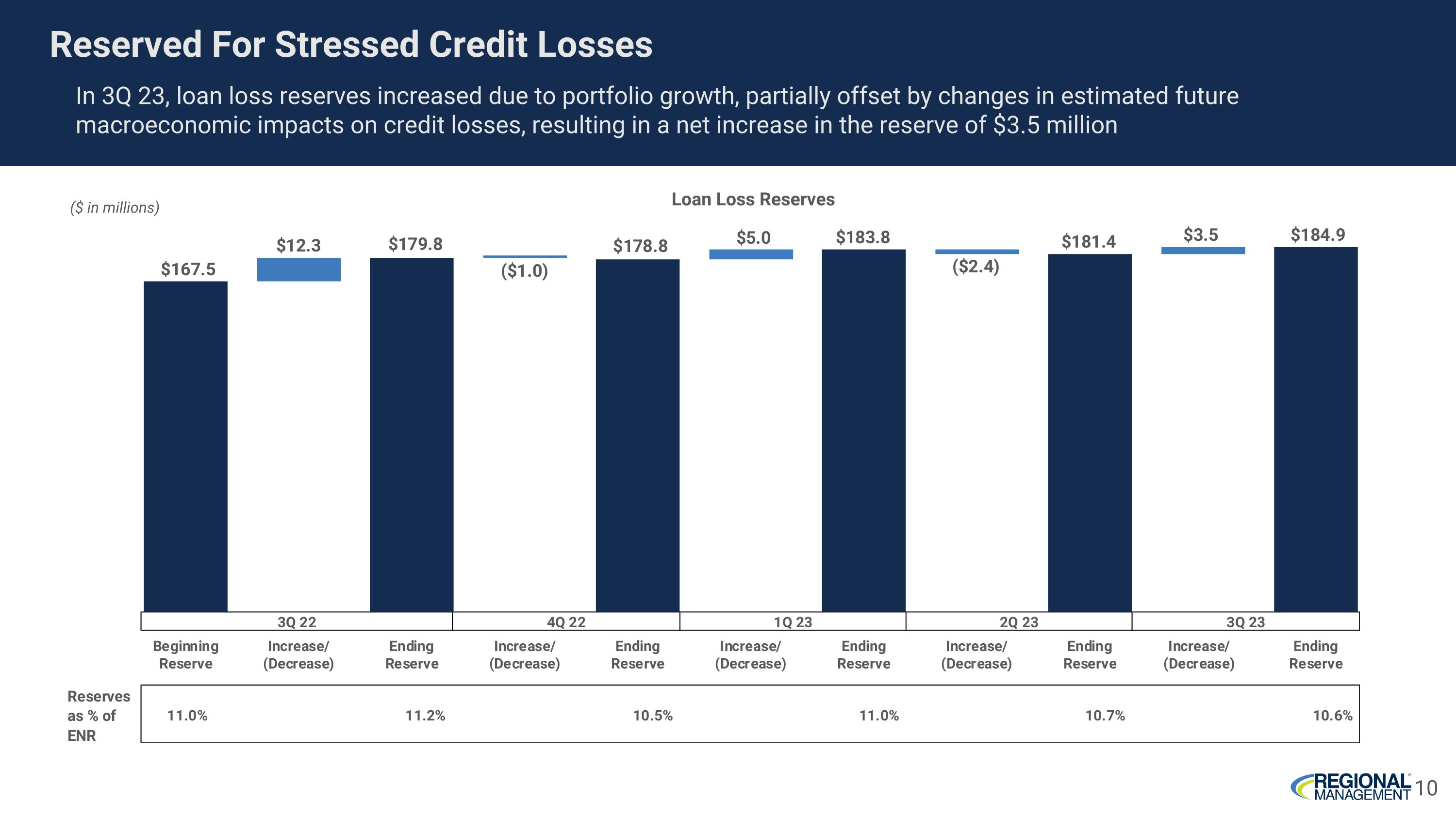
Reserved For Stressed Credit Losses In 3Q 23, loan loss reserves increased due to portfolio growth, partially offset by changes in estimated future macroeconomic impacts on credit losses, resulting in a net increase in the reserve of $3.5 million 10 ($ in millions) Loan Loss Reserves
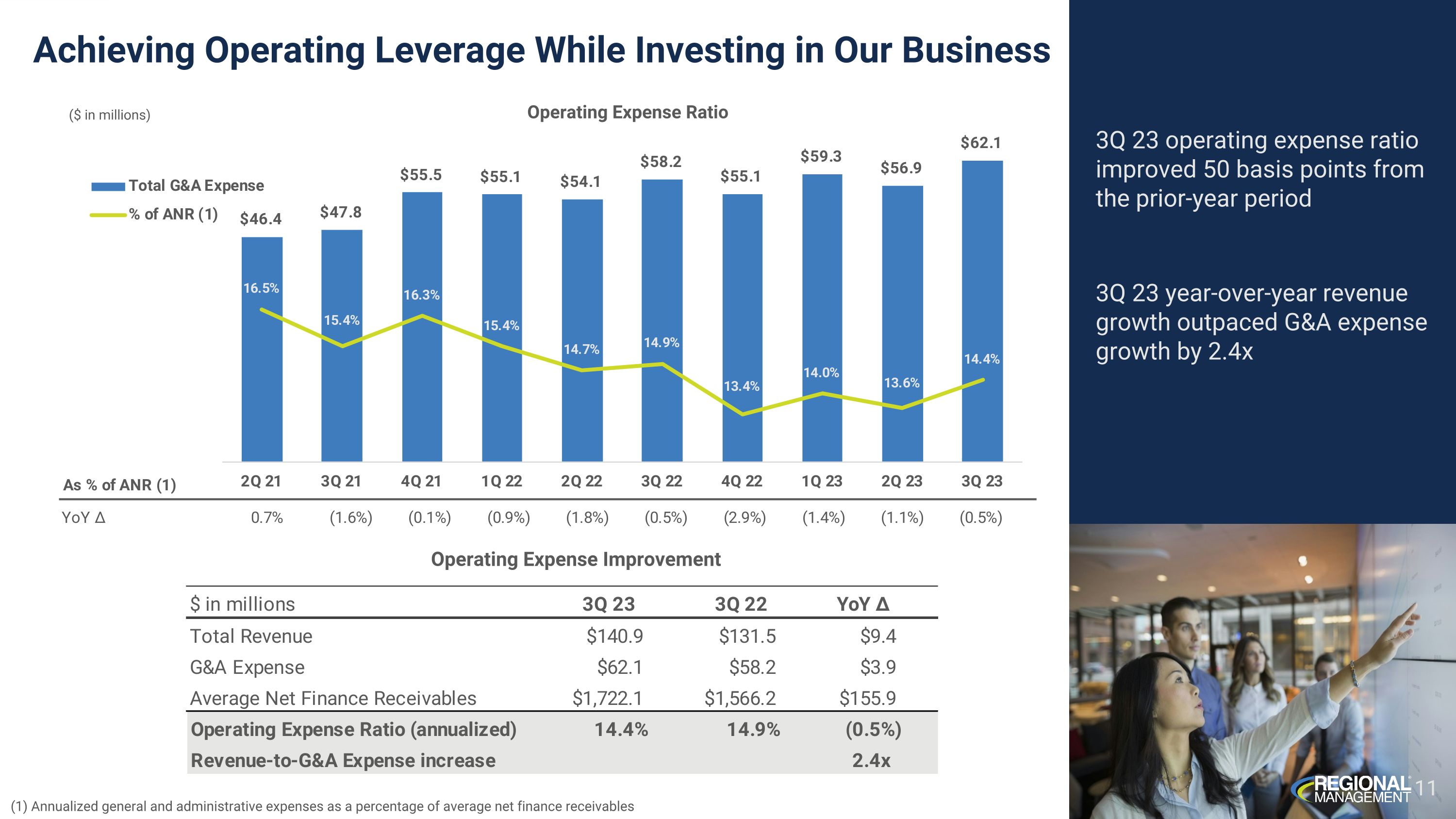
Achieving Operating Leverage While Investing in Our Business 3Q 23 operating expense ratio improved 50 basis points from the prior-year period 3Q 23 year-over-year revenue growth outpaced G&A expense growth by 2.4x Operating Expense Ratio (1) Annualized general and administrative expenses as a percentage of average net finance receivables ($ in millions) Operating Expense Improvement 11
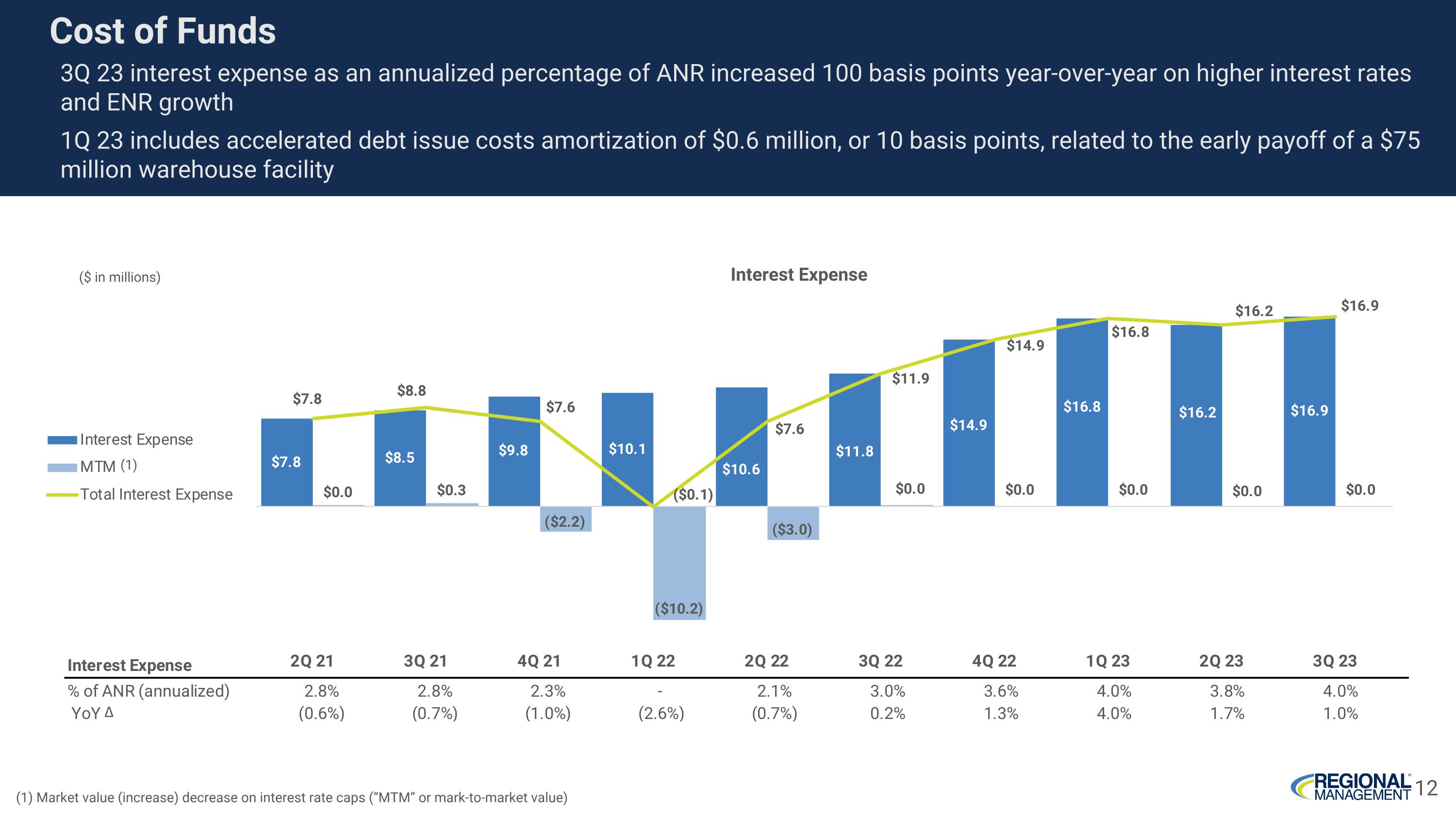
12 3Q 23 interest expense as an annualized percentage of ANR increased 100 basis points year-over-year on higher interest rates and ENR growth 1Q 23 includes accelerated debt issue costs amortization of $0.6 million, or 10 basis points, related to the early payoff of a $75 million warehouse facility Interest Expense ($ in millions) (1) Cost of Funds (1) Market value (increase) decrease on interest rate caps (“MTM” or mark-to-market value)
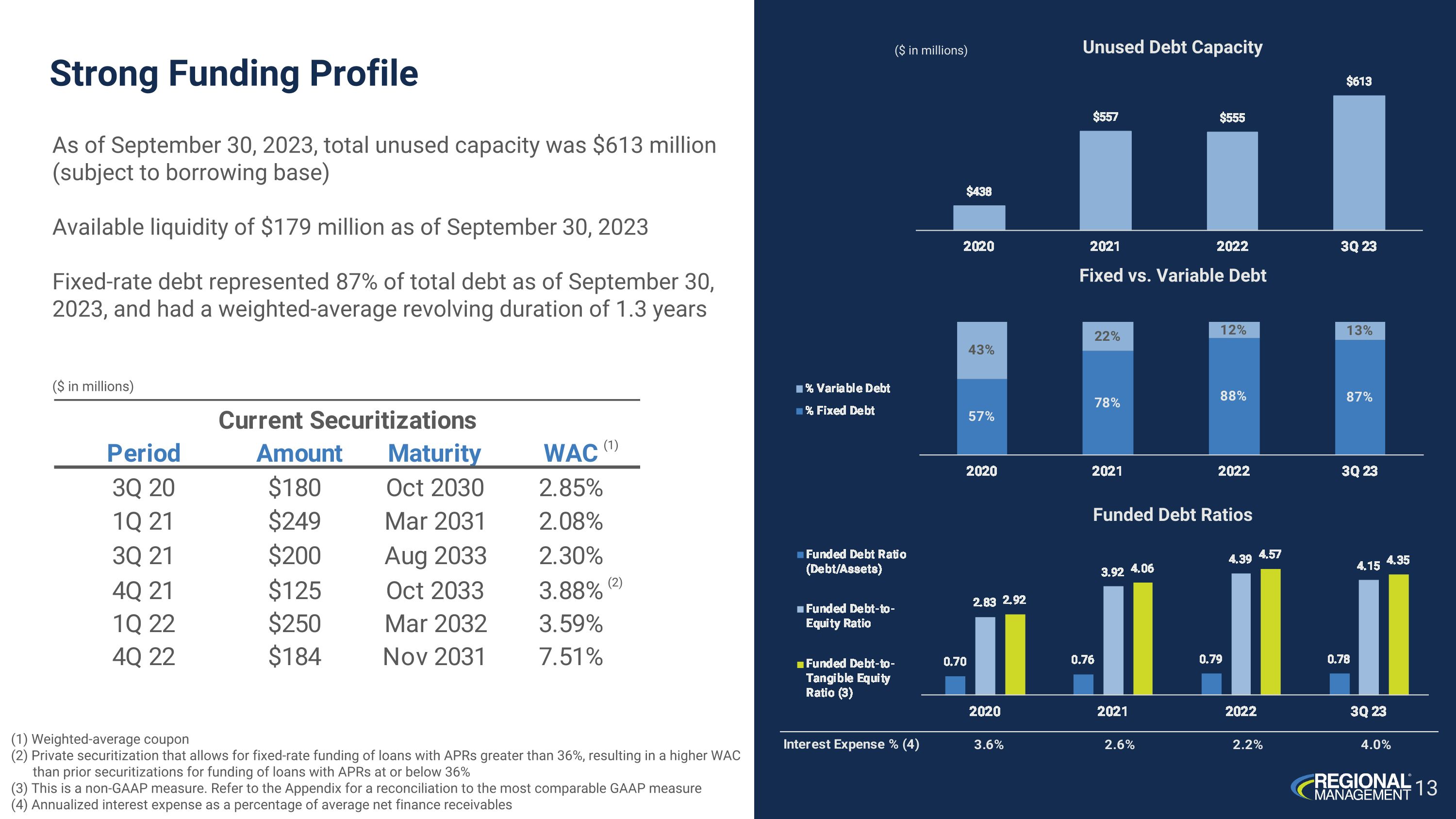
As of September 30, 2023, total unused capacity was $613 million (subject to borrowing base) Available liquidity of $179 million as of September 30, 2023 Fixed-rate debt represented 87% of total debt as of September 30, 2023, and had a weighted-average revolving duration of 1.3 years Strong Funding Profile Unused Debt Capacity Fixed vs. Variable Debt Funded Debt Ratios 13 ($ in millions) (1) Weighted-average coupon (2) Private securitization that allows for fixed-rate funding of loans with APRs greater than 36%, resulting in a higher WAC than prior securitizations for funding of loans with APRs at or below 36% (3) This is a non-GAAP measure. Refer to the Appendix for a reconciliation to the most comparable GAAP measure (4) Annualized interest expense as a percentage of average net finance receivables (2) (1) ($ in millions)
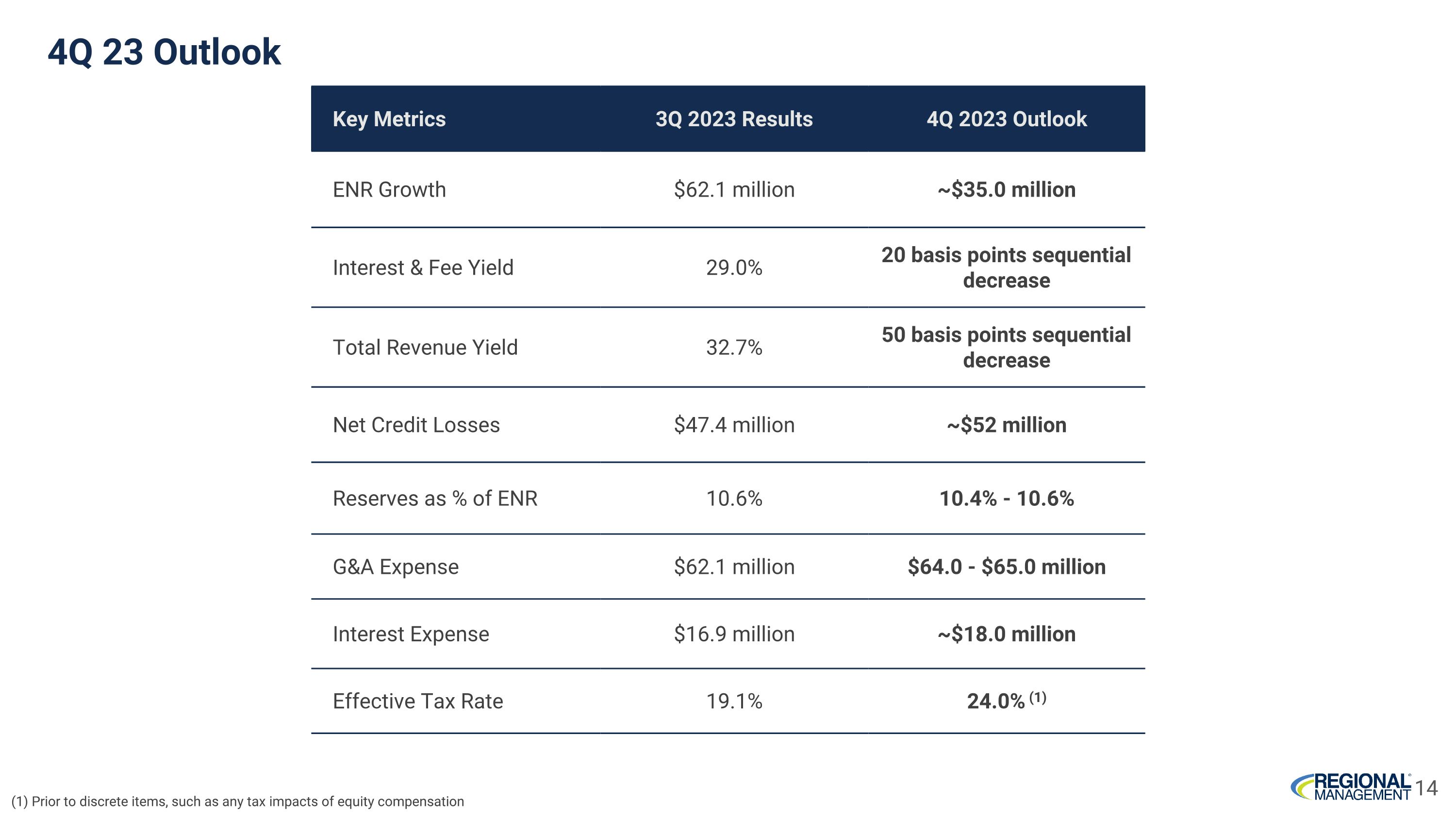
4Q 23 Outlook Key Metrics 3Q 2023 Results 4Q 2023 Outlook ENR Growth $62.1 million ~$35.0 million Interest & Fee Yield 29.0% 20 basis points sequential decrease Total Revenue Yield 32.7% 50 basis points sequential decrease Net Credit Losses $47.4 million ~$52 million Reserves as % of ENR 10.6% 10.4% - 10.6% G&A Expense $62.1 million $64.0 - $65.0 million Interest Expense $16.9 million ~$18.0 million Effective Tax Rate 19.1% 24.0% (1) (1) Prior to discrete items, such as any tax impacts of equity compensation 14

Appendix 15
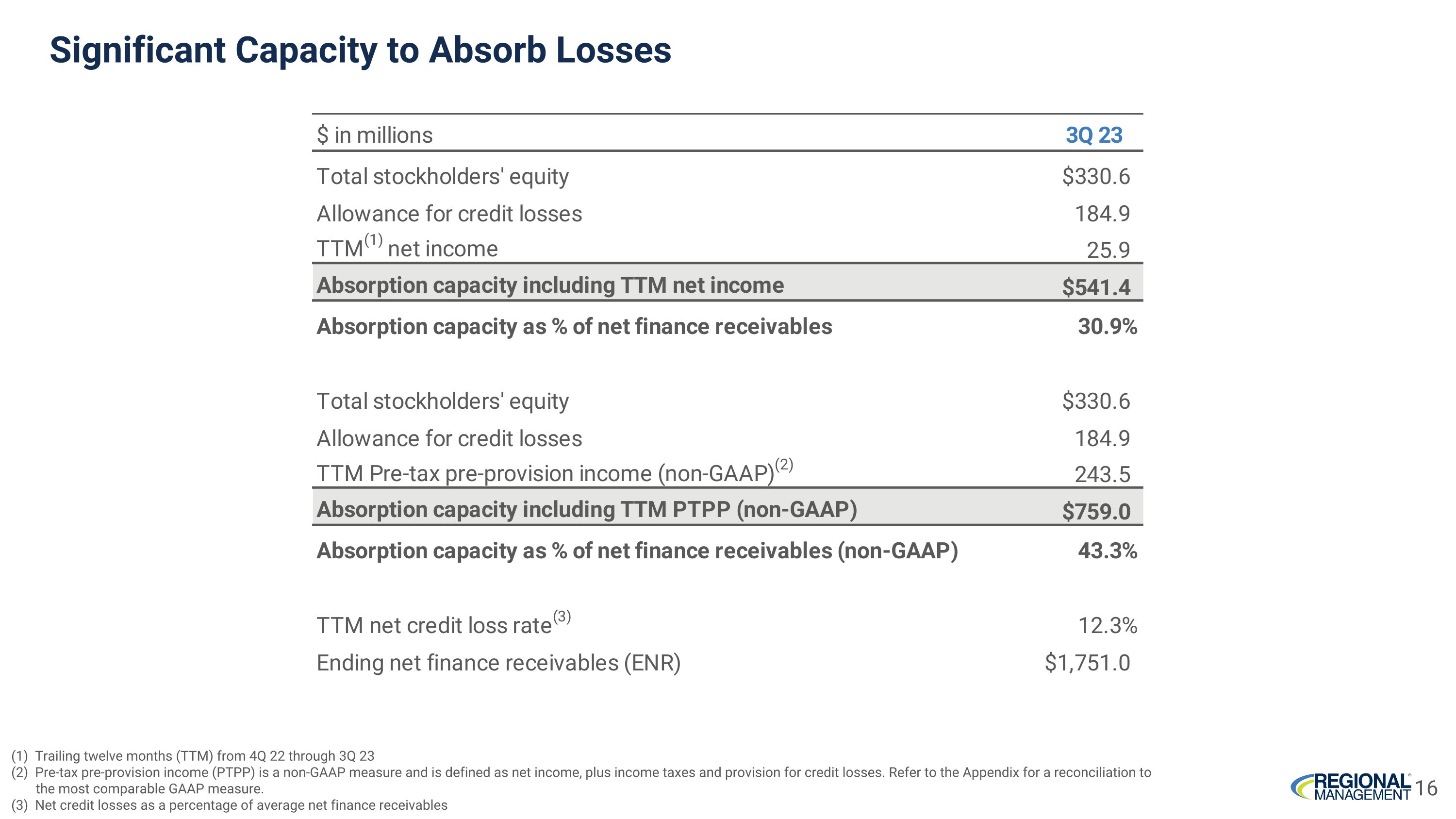
Significant Capacity to Absorb Losses (1) Trailing twelve months (TTM) from 4Q 22 through 3Q 23 (2) Pre-tax pre-provision income (PTPP) is a non-GAAP measure and is defined as net income, plus income taxes and provision for credit losses. Refer to the Appendix for a reconciliation to the most comparable GAAP measure. (3) Net credit losses as a percentage of average net finance receivables 16
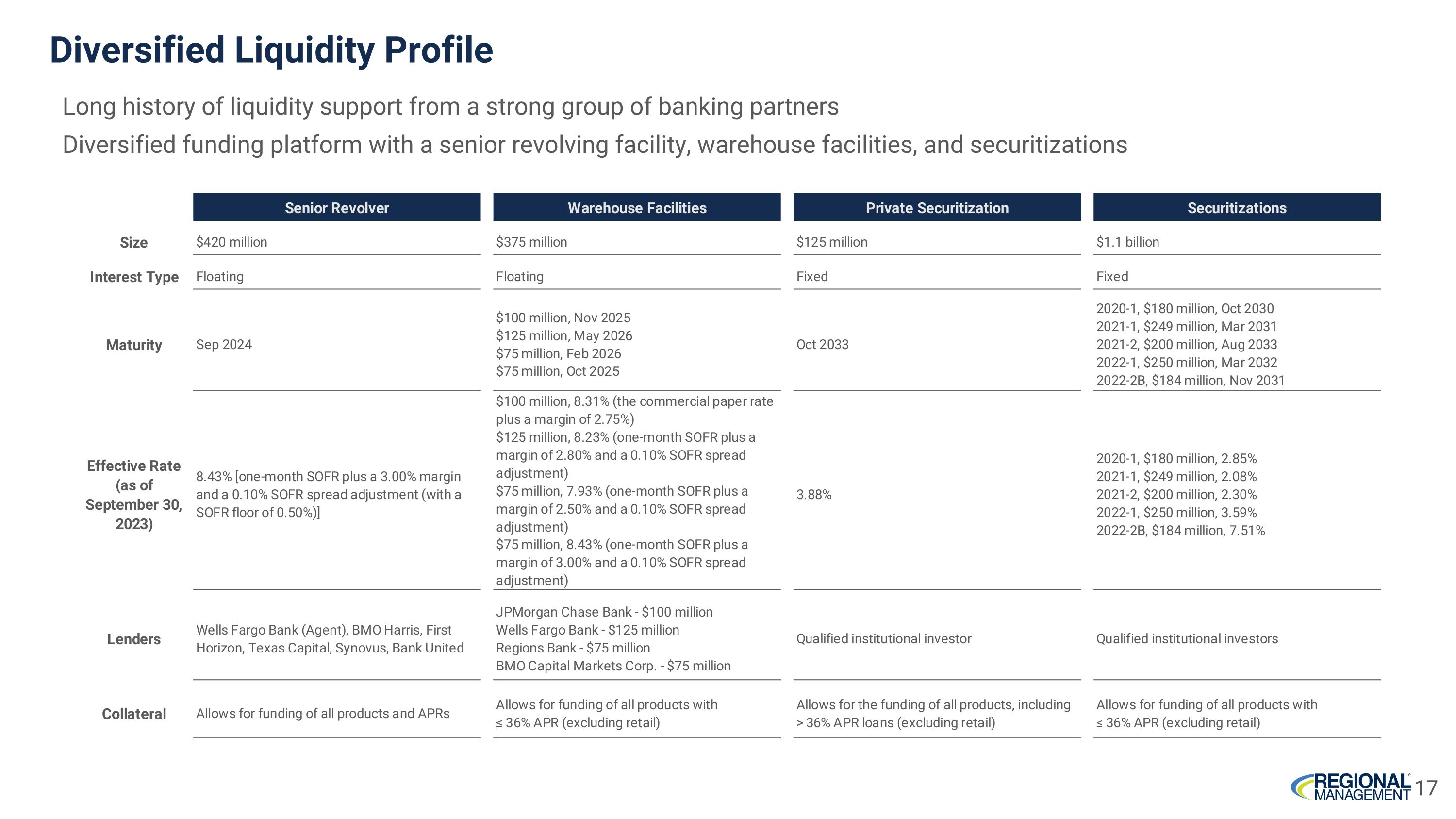
Diversified Liquidity Profile Long history of liquidity support from a strong group of banking partners Diversified funding platform with a senior revolving facility, warehouse facilities, and securitizations 17
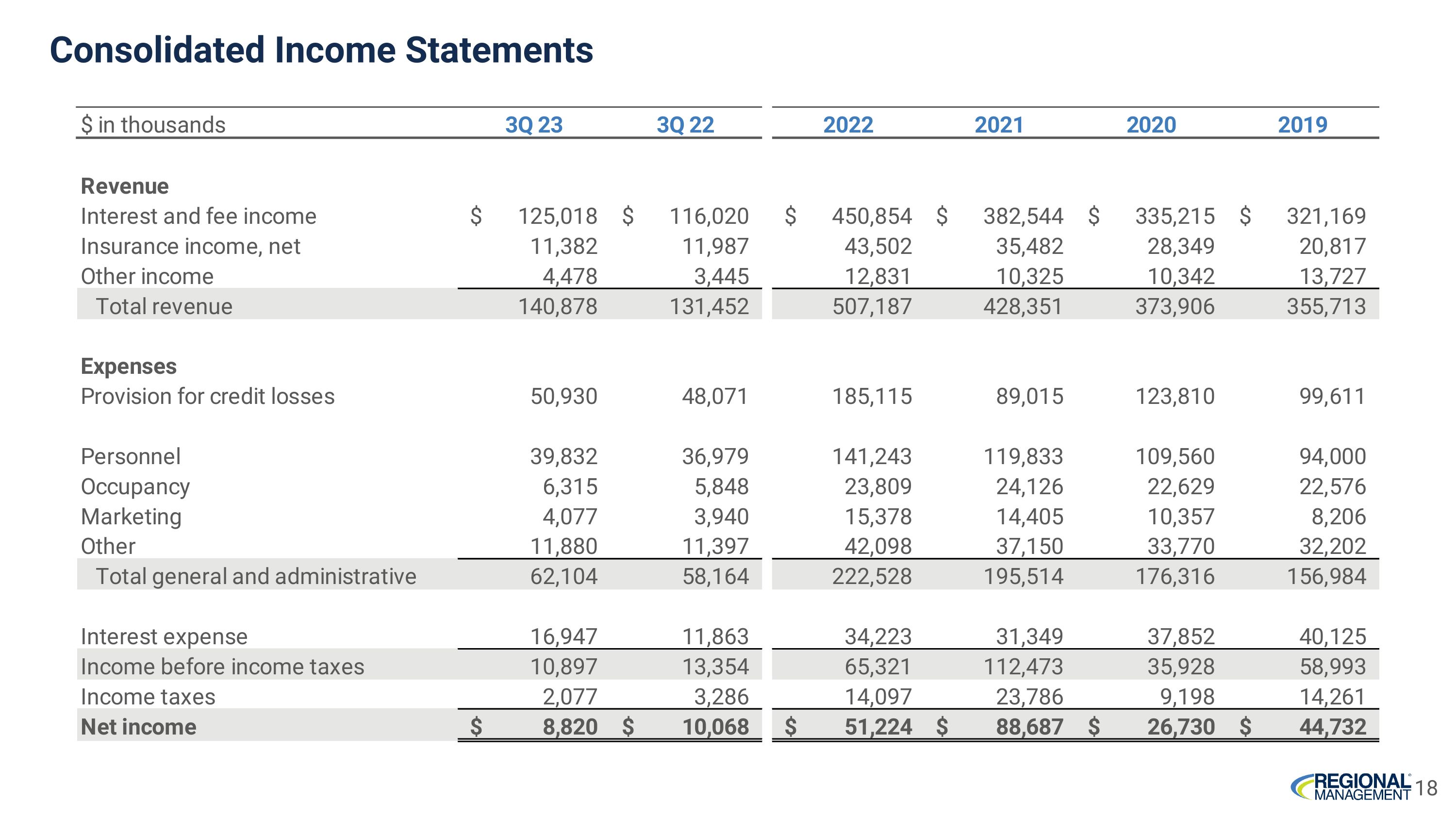
Consolidated Income Statements 18
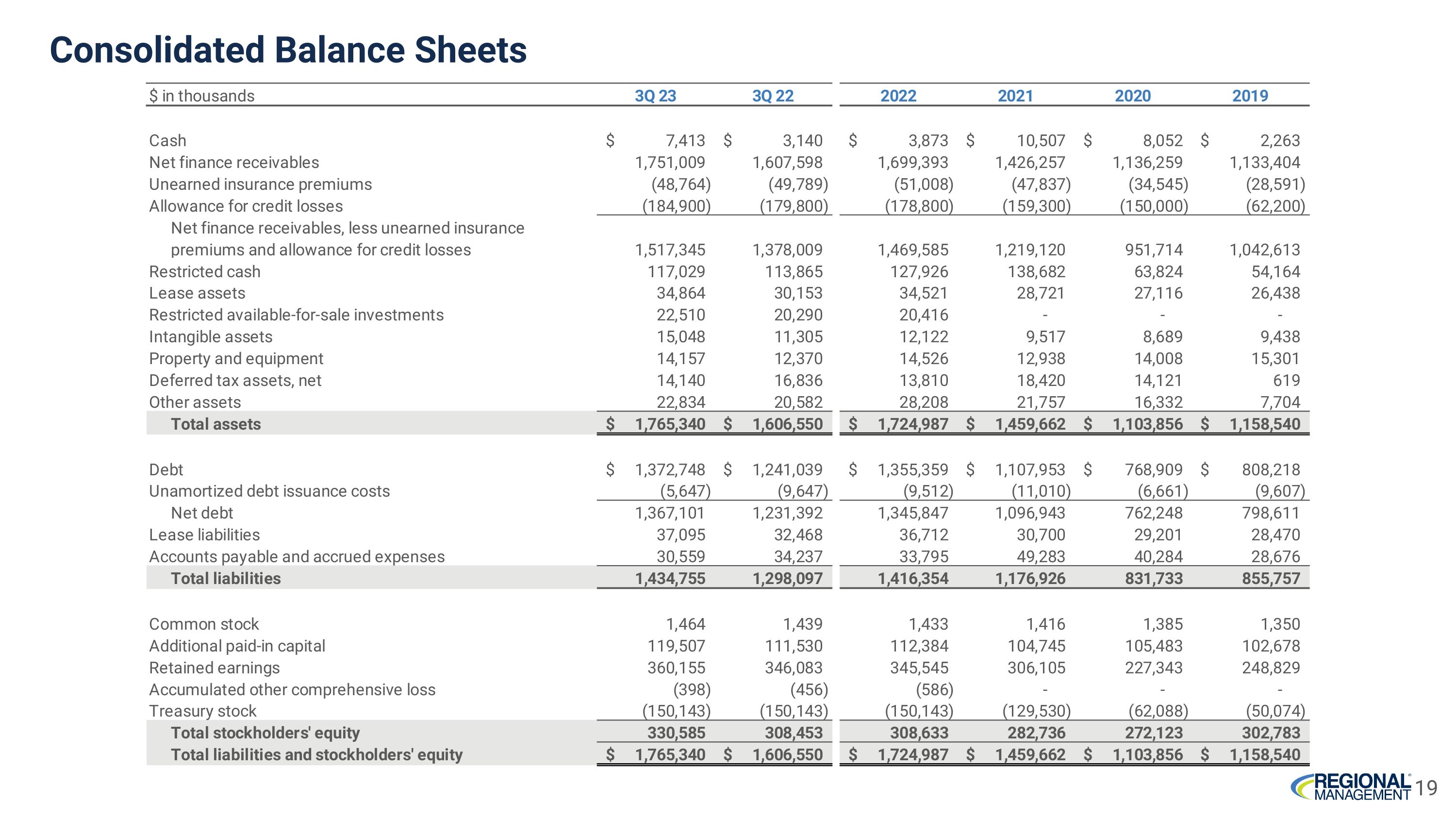
Consolidated Balance Sheets 19
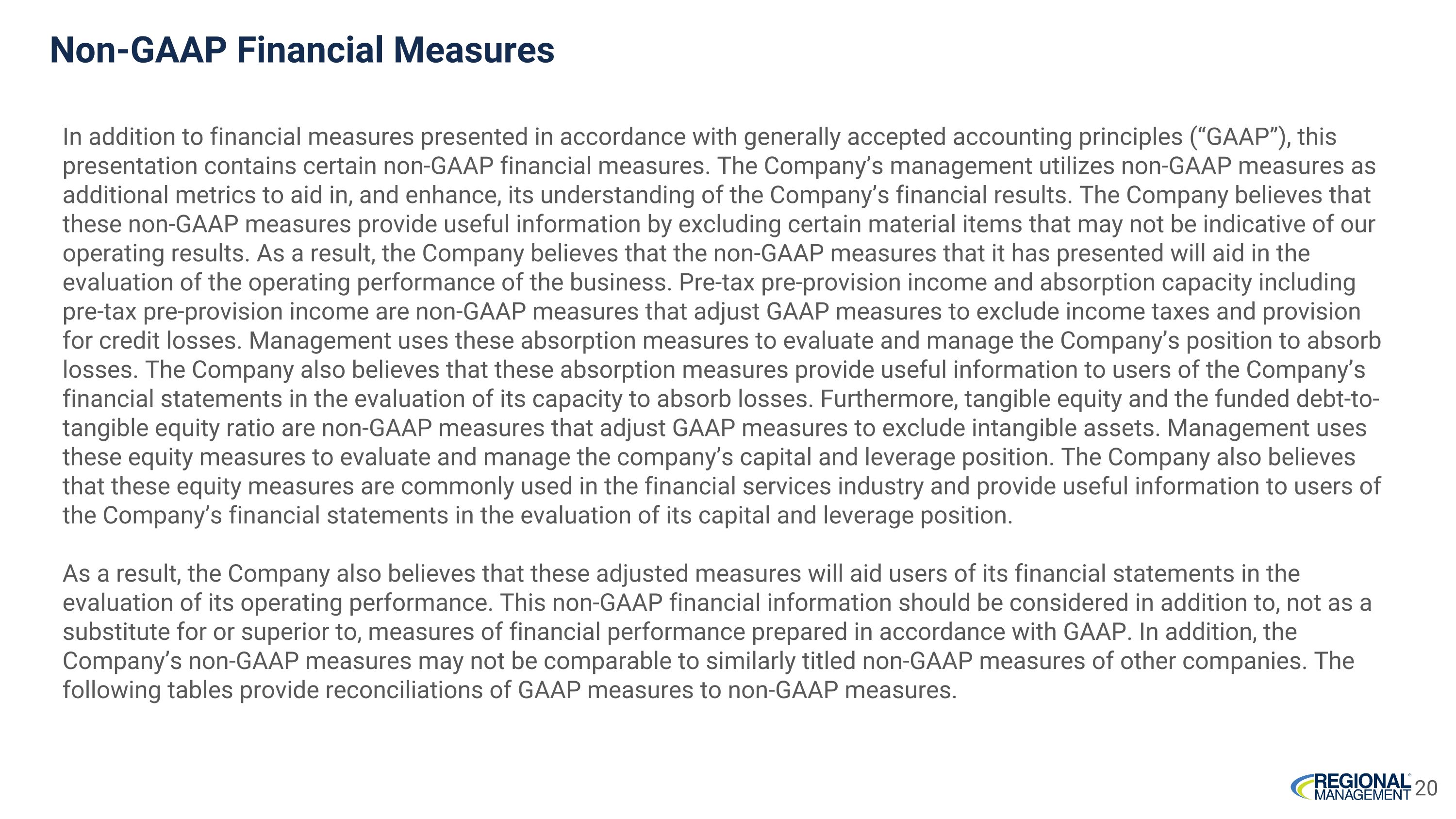
Non-GAAP Financial Measures In addition to financial measures presented in accordance with generally accepted accounting principles (“GAAP”), this presentation contains certain non-GAAP financial measures. The Company’s management utilizes non-GAAP measures as additional metrics to aid in, and enhance, its understanding of the Company’s financial results. The Company believes that these non-GAAP measures provide useful information by excluding certain material items that may not be indicative of our operating results. As a result, the Company believes that the non-GAAP measures that it has presented will aid in the evaluation of the operating performance of the business. Pre-tax pre-provision income and absorption capacity including pre-tax pre-provision income are non-GAAP measures that adjust GAAP measures to exclude income taxes and provision for credit losses. Management uses these absorption measures to evaluate and manage the Company’s position to absorb losses. The Company also believes that these absorption measures provide useful information to users of the Company’s financial statements in the evaluation of its capacity to absorb losses. Furthermore, tangible equity and the funded debt-to-tangible equity ratio are non-GAAP measures that adjust GAAP measures to exclude intangible assets. Management uses these equity measures to evaluate and manage the company’s capital and leverage position. The Company also believes that these equity measures are commonly used in the financial services industry and provide useful information to users of the Company’s financial statements in the evaluation of its capital and leverage position. As a result, the Company also believes that these adjusted measures will aid users of its financial statements in the evaluation of its operating performance. This non-GAAP financial information should be considered in addition to, not as a substitute for or superior to, measures of financial performance prepared in accordance with GAAP. In addition, the Company’s non-GAAP measures may not be comparable to similarly titled non-GAAP measures of other companies. The following tables provide reconciliations of GAAP measures to non-GAAP measures. 20
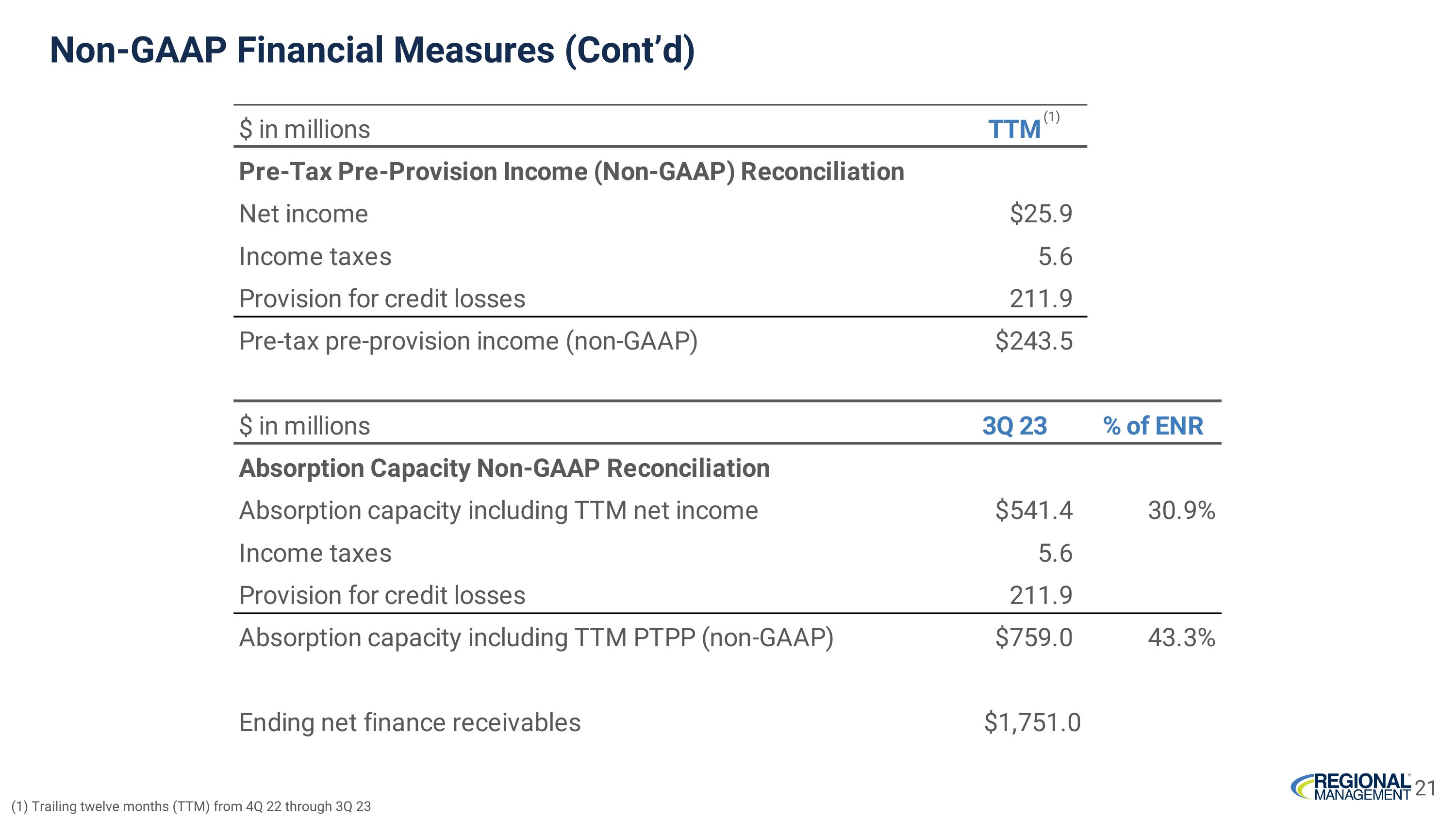
Non-GAAP Financial Measures (Cont’d) 21 (1) Trailing twelve months (TTM) from 4Q 22 through 3Q 23 (1)
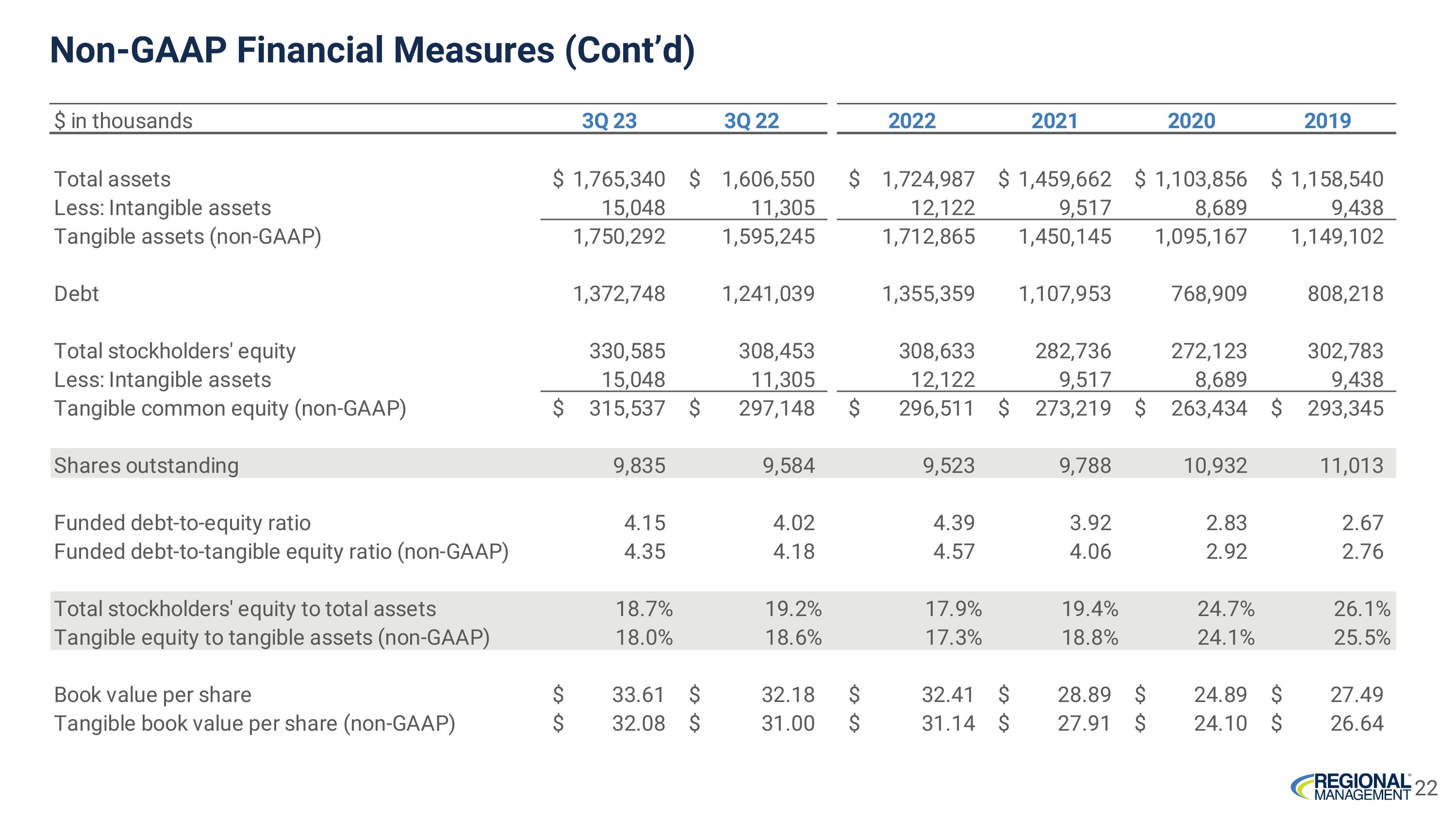
Non-GAAP Financial Measures (Cont’d) 22





















